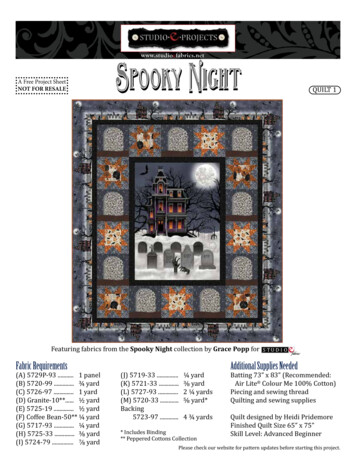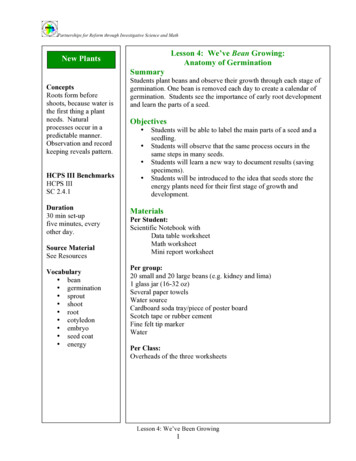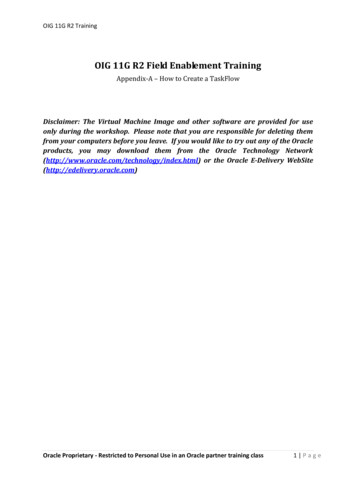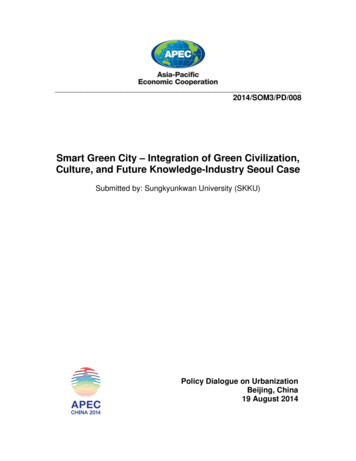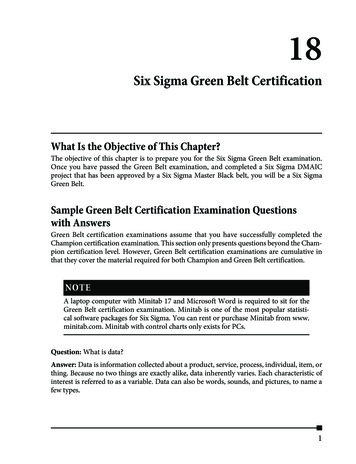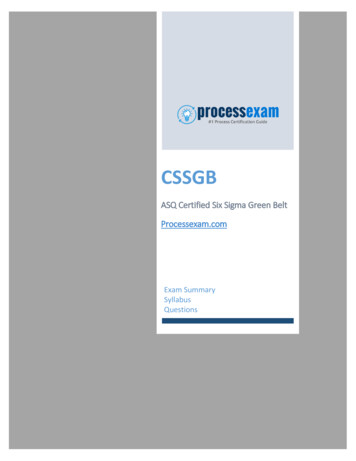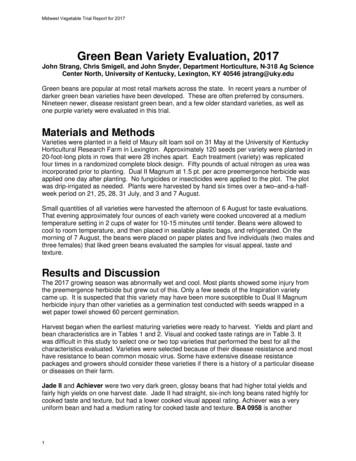
Transcription
Midwest Vegetable Trial Report for 2017Green Bean Variety Evaluation, 2017John Strang, Chris Smigell, and John Snyder, Department Horticulture, N-318 Ag ScienceCenter North, University of Kentucky, Lexington, KY 40546 jstrang@uky.eduGreen beans are popular at most retail markets across the state. In recent years a number ofdarker green bean varieties have been developed. These are often preferred by consumers.Nineteen newer, disease resistant green bean, and a few older standard varieties, as well asone purple variety were evaluated in this trial.Materials and MethodsVarieties were planted in a field of Maury silt loam soil on 31 May at the University of KentuckyHorticultural Research Farm in Lexington. Approximately 120 seeds per variety were planted in20-foot-long plots in rows that were 28 inches apart. Each treatment (variety) was replicatedfour times in a randomized complete block design. Fifty pounds of actual nitrogen as urea wasincorporated prior to planting. Dual II Magnum at 1.5 pt. per acre preemergence herbicide wasapplied one day after planting. No fungicides or insecticides were applied to the plot. The plotwas drip-irrigated as needed. Plants were harvested by hand six times over a two–and-a-halfweek period on 21, 25, 28, 31 July, and 3 and 7 August.Small quantities of all varieties were harvested the afternoon of 6 August for taste evaluations.That evening approximately four ounces of each variety were cooked uncovered at a mediumtemperature setting in 2 cups of water for 10-15 minutes until tender. Beans were allowed tocool to room temperature, and then placed in sealable plastic bags, and refrigerated. On themorning of 7 August, the beans were placed on paper plates and five individuals (two males andthree females) that liked green beans evaluated the samples for visual appeal, taste andtexture.Results and DiscussionThe 2017 growing season was abnormally wet and cool. Most plants showed some injury fromthe preemergence herbicide but grew out of this. Only a few seeds of the Inspiration varietycame up. It is suspected that this variety may have been more susceptible to Dual II Magnumherbicide injury than other varieties as a germination test conducted with seeds wrapped in awet paper towel showed 60 percent germination.Harvest began when the earliest maturing varieties were ready to harvest. Yields and plant andbean characteristics are in Tables 1 and 2. Visual and cooked taste ratings are in Table 3. Itwas difficult in this study to select one or two top varieties that performed the best for all thecharacteristics evaluated. Varieties were selected because of their disease resistance and mosthave resistance to bean common mosaic virus. Some have extensive disease resistancepackages and growers should consider these varieties if there is a history of a particular diseaseor diseases on their farm.Jade II and Achiever were two very dark green, glossy beans that had higher total yields andfairly high yields on one harvest date. Jade II had straight, six-inch long beans rated highly forcooked taste and texture, but had a lower cooked visual appeal rating. Achiever was a veryuniform bean and had a medium rating for cooked taste and texture. BA 0958 is another1
Midwest Vegetable Trial Report for 2017attractive, slightly glossy, dark green, round bean with a lower yield, but rated very highly forpod straightness, uniformity and both raw- and cooked visual appeal, taste and texture.Colter, Opportune and Momentum green beans were lighter green and yielded well. Colterbeans were slim, uniform and highly rated for raw visual appeal and cooked taste, visual appealand texture. The Opportune variety held its beans up off the ground well, beans retained theirstems well during picking, and it had one of the highest cooked taste ratings. Momentum wasone of the highest yielding green beans and was also one of the highest yielding on one harvestdate. Its beans were attractive, slightly glossy, but rated fairly low for taste when cooked.Furano, a light green colored, flat bean was one of the highest yielding in the trial. It performedslightly better than the other flat green bean, Greencrop. Beans were very straight, retained theirstems well at harvest and were rated highly for raw visual appeal and rated midway with respectto the other varieties for cooked visual appeal, taste and texture.Amethyst, the only purple bean in the trial, had a very high total yield and one-time harvestyield. Beans were very straight and rated very highly for raw visual appeal as well as cookedvisual appeal, taste and texture. This purple bean turns olive green when cooked and thecooking water turns lime green. The purple coloring on the fresh beans is not uniform over theentire bean and there are grayish green areas, mostly on the side of the bean with less sunlightexposure.The Orient green bean is notable in that it was one of the highest rated varieties for visualappeal, taste and texture when cooked. It has attractive, slim, short, very straight, uniform, lightgreen beans, but lower yields. It has an extensive disease resistance package and is a specialtymarket item that may be attractive to restaurants because the beans can be served whole.AcknowledgmentsThe authors would like to thank the following individuals for their hard work and assistance inthe successful completion of this trial: Joseph Tucker, John Walsh, Dave Lowry, Grant Clouser,Steve Diver, Somjintana Sutthithanakool and Kanokwan Khanthawong.Funding for this project was provided by a grant from the Kentucky Horticultural Council throughthe Agricultural Development Fund.2
Midwest Vegetable Trial Report for 2017Table 1. Days to harvest, yields, and disease resistances.Total Yield6 Harvests (bu/A)2LargestYield 1 Harvest(bu/A)2,3Largest YieldHarvest(Date)VarietySeed SourceDays toHarvest1Disease Resistance(1-5)4FuranoST54785 a284 abc7/25HR: BCMVAmethystJS56711 ab239 bc8/11R: BCMVGreencropSW52697 abc284 abc7/29R: BCMVMomentumSY56691 abc354 a7/28HR: BCMVCapriceSW56654 bcd198 cd7/29HR: BCMV, HB, Xap; IR: BBSAchieverSW53632 bcde337 ab7/25IR: whitefliesJade IIBL60610 bcde249 bc7/25HR: BCMV; IR: RustColterCF53582 cdef218 cd7/26HR: BCMV, BCTV, RustOpportuneSY56557 def207 cd7/28HR: BCMVCosmosJS56551 defg202 cd7/31HR: BCMV, BCTV; IR: BBSBowieSW54543 efgh282 abc7/28HR: BCMV, BCTV, HB, BBS; IR: XapBroncoHO53543 efgh206 cd7/28IR: BCMVSybarisST56530 efgh187 cd7/28HR: BCMV; IR: Rust 90AmbitionCF54519 efgh217 cd7/29R: BCMV; IR: whitefliesBA 0958ST53510 efgh241 bc7/29R: BCMV; IR: BBS, root rotAnnihilatorCF54462 fgh197 cd7/27R: BCMV, BCTVOrientJS55427 gh229 c7/30HR: BCMV, HB; IR: BBS, BCTVSerengetiSY55418 h201 cd7/31HR: BCMVSlenderetteHO53233 i114 d8/4BCMV, BCTV, BPMVDays to harvest as reported by seed companies.2Means in the same column followed by the same letters are not significantly different (Waller-Duncan multiple range test LSD P 0.05).3Highest yield obtained on one harvest date.4Disease resistance from seed company catalogues: HR high resistance; R resistance; IR intermediate resistance;BPMV pod mottle virus; BCMV common mosaic virus; BCTV beet curly top virus; HB halo blight; Xap common bacterial blight;BBS bacterial brown spot; Rust common rust.13
Midwest Vegetable Trial Report for 2017Table 2. Plant and bean Amethyst19244.51.5-74.25.33.973Attractive, flat beanPod color not uniform, purple with ve, flat, lt green podMomentum19253.42.43.43.75.63.975Attractive, uniform, slim, slightly glossyCaprice20243.53.03.03.55.83.980Attractive, slightly glossyAchiever16214.02.04.04.25.54.178Attractive, slightly glossyJade II17243.92.14.03.66.03.773Attractive, slim, glossyColter17224.12.53.13.95.53.988Slim beanOpportune18222.82.63.13.65.63.698Attractive, slim, glossyCosmos18253.31.92.93.05.53.260Light colored, beans curledBowie20233.82.93.73.95.04.070Attractive, uniform, slightly glossy, breakseasily during harvestBronco18243.52.13.03.75.04.097Attractive, slim, picks easilySybaris18214.11.84.03.55.53.685Slim, slightly glossyAmbition17204.02.64.04.15.54.088Very attractive, uniform, slim, slightlyglossyBA 095819243.82.94.04.05.74.385Attractive, slightly 03.92.32.94.34.04.385Not glossyAttractive, short bean, harvests easily,specialty marketSerengeti18243.02.63.04.36.04.165Attractive, straight, slimSlenderette17223.52.12.93.94.63.7Plant habit: 1 prone; 3 moderate; 5 erect.2Pod position: 1 all pods on ground; 3 just off ground; 5 high.3Pod color: 1 light; 3 medium; 5 dark green.4Pod straightness: 1 J curve; 5 straight.5Pod uniformity; 1 poor; 3 average; 5 excellent.6Percent of beans with stems still attached after picking, determined from a random sample of 10 beans.7Purple pods.95Attractive, light green14Comments
Midwest Vegetable Trial Report for 2017Table 3. Visual and taste ratings for fresh green beans.VisualAppeal -5)1,2TextureCOOKED( 1-5)1,2Sum ofAllRatings3.84.13.64.215.7Uniform dk green44.03.64.015.6Dk greenBowie3.93.93.54.015.3Uniform dk greenOpportune4.23.64.13.415.3Lt-dk green, variableAmethyst3.63.73.74.215.2Olive greenColter3.84.33.63.415.1Dk greenCosmos3.73.93.34.014.9Lt-dk green, variableAmbition3.93.53.63.814.8Dk greenSlenderette3.93.43.63.814.7Lt greenAnnihilator3.34.33.63.414.6Dk greenAchiever44.13.13.414.6Dk greenSybaris3.63.63.13.613.9Dk greenFurano3.83.33.33.413.8Lt greenJade II3.22.93.83.813.7Very dk greenVarietyOrientBA 0958Serengeti33.73.13.613.4Lt-dk green variable3.43.52.83.713.4Variable colorCaprice43.32.52.812.6Lt greenBronco3.33.02.33.812.4Lt green, firmGreencrop2.93.02.91Rating 1 poor; 5 excellent.2Participants 5 (2 males, 3 females); All liked green beans.2.411.2Lt green, variableMomentum5Cooked Color
Green Bean Variety Evaluation , 2017 . John Strang, Chris Smigell, and John Snyder, Department Horticulture, N-318 Ag Science Center North, University of Kentucky, Lexington, KY 40546 jstrang@uky.edu. Green beans are popular at most retail markets across the state. In recent years a n

